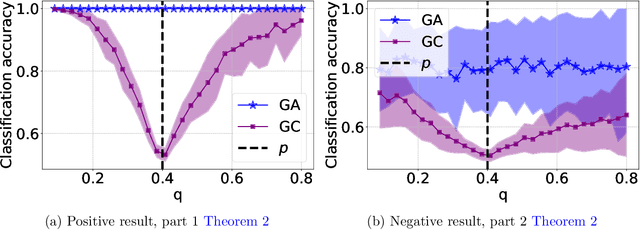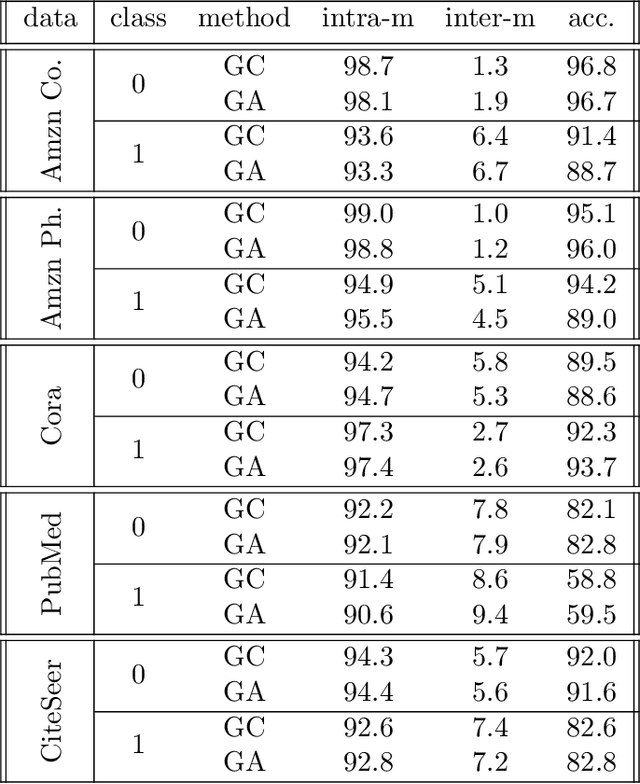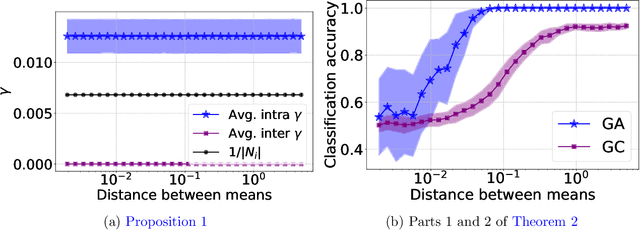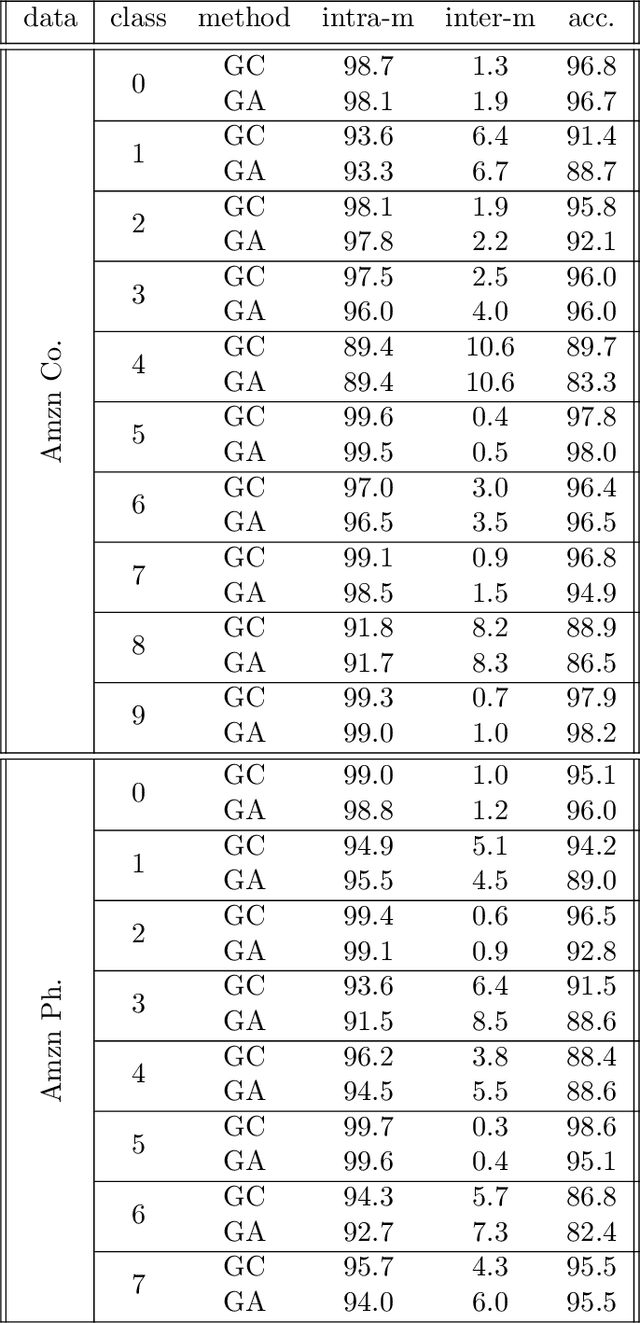Silvio Lattanzi
Clustering with Label Consistency
Dec 22, 2025Abstract:Designing efficient, effective, and consistent metric clustering algorithms is a significant challenge attracting growing attention. Traditional approaches focus on the stability of cluster centers; unfortunately, this neglects the real-world need for stable point labels, i.e., stable assignments of points to named sets (clusters). In this paper, we address this gap by initiating the study of label-consistent metric clustering. We first introduce a new notion of consistency, measuring the label distance between two consecutive solutions. Then, armed with this new definition, we design new consistent approximation algorithms for the classical $k$-center and $k$-median problems.
The Cost of Consistency: Submodular Maximization with Constant Recourse
Dec 03, 2024



Abstract:In this work, we study online submodular maximization, and how the requirement of maintaining a stable solution impacts the approximation. In particular, we seek bounds on the best-possible approximation ratio that is attainable when the algorithm is allowed to make at most a constant number of updates per step. We show a tight information-theoretic bound of $\tfrac{2}{3}$ for general monotone submodular functions, and an improved (also tight) bound of $\tfrac{3}{4}$ for coverage functions. Since both these bounds are attained by non poly-time algorithms, we also give a poly-time randomized algorithm that achieves a $0.51$-approximation. Combined with an information-theoretic hardness of $\tfrac{1}{2}$ for deterministic algorithms from prior work, our work thus shows a separation between deterministic and randomized algorithms, both information theoretically and for poly-time algorithms.
Dynamic Correlation Clustering in Sublinear Update Time
Jun 13, 2024Abstract:We study the classic problem of correlation clustering in dynamic node streams. In this setting, nodes are either added or randomly deleted over time, and each node pair is connected by a positive or negative edge. The objective is to continuously find a partition which minimizes the sum of positive edges crossing clusters and negative edges within clusters. We present an algorithm that maintains an $O(1)$-approximation with $O$(polylog $n$) amortized update time. Prior to our work, Behnezhad, Charikar, Ma, and L. Tan achieved a $5$-approximation with $O(1)$ expected update time in edge streams which translates in node streams to an $O(D)$-update time where $D$ is the maximum possible degree. Finally we complement our theoretical analysis with experiments on real world data.
Multi-View Stochastic Block Models
Jun 07, 2024Abstract:Graph clustering is a central topic in unsupervised learning with a multitude of practical applications. In recent years, multi-view graph clustering has gained a lot of attention for its applicability to real-world instances where one has access to multiple data sources. In this paper we formalize a new family of models, called \textit{multi-view stochastic block models} that captures this setting. For this model, we first study efficient algorithms that naively work on the union of multiple graphs. Then, we introduce a new efficient algorithm that provably outperforms previous approaches by analyzing the structure of each graph separately. Furthermore, we complement our results with an information-theoretic lower bound studying the limits of what can be done in this model. Finally, we corroborate our results with experimental evaluations.
Consistent Submodular Maximization
May 30, 2024


Abstract:Maximizing monotone submodular functions under cardinality constraints is a classic optimization task with several applications in data mining and machine learning. In this paper we study this problem in a dynamic environment with consistency constraints: elements arrive in a streaming fashion and the goal is maintaining a constant approximation to the optimal solution while having a stable solution (i.e., the number of changes between two consecutive solutions is bounded). We provide algorithms in this setting with different trade-offs between consistency and approximation quality. We also complement our theoretical results with an experimental analysis showing the effectiveness of our algorithms in real-world instances.
A Scalable Algorithm for Individually Fair K-means Clustering
Feb 09, 2024



Abstract:We present a scalable algorithm for the individually fair ($p$, $k$)-clustering problem introduced by Jung et al. and Mahabadi et al. Given $n$ points $P$ in a metric space, let $\delta(x)$ for $x\in P$ be the radius of the smallest ball around $x$ containing at least $n / k$ points. A clustering is then called individually fair if it has centers within distance $\delta(x)$ of $x$ for each $x\in P$. While good approximation algorithms are known for this problem no efficient practical algorithms with good theoretical guarantees have been presented. We design the first fast local-search algorithm that runs in ~$O(nk^2)$ time and obtains a bicriteria $(O(1), 6)$ approximation. Then we show empirically that not only is our algorithm much faster than prior work, but it also produces lower-cost solutions.
A quasi-polynomial time algorithm for Multi-Dimensional Scaling via LP hierarchies
Nov 29, 2023
Abstract:Multi-dimensional Scaling (MDS) is a family of methods for embedding pair-wise dissimilarities between $n$ objects into low-dimensional space. MDS is widely used as a data visualization tool in the social and biological sciences, statistics, and machine learning. We study the Kamada-Kawai formulation of MDS: given a set of non-negative dissimilarities $\{d_{i,j}\}_{i , j \in [n]}$ over $n$ points, the goal is to find an embedding $\{x_1,\dots,x_n\} \subset \mathbb{R}^k$ that minimizes \[ \text{OPT} = \min_{x} \mathbb{E}_{i,j \in [n]} \left[ \left(1-\frac{\|x_i - x_j\|}{d_{i,j}}\right)^2 \right] \] Despite its popularity, our theoretical understanding of MDS is extremely limited. Recently, Demaine, Hesterberg, Koehler, Lynch, and Urschel (arXiv:2109.11505) gave the first approximation algorithm with provable guarantees for Kamada-Kawai, which achieves an embedding with cost $\text{OPT} +\epsilon$ in $n^2 \cdot 2^{\tilde{\mathcal{O}}(k \Delta^4 / \epsilon^2)}$ time, where $\Delta$ is the aspect ratio of the input dissimilarities. In this work, we give the first approximation algorithm for MDS with quasi-polynomial dependency on $\Delta$: for target dimension $k$, we achieve a solution with cost $\mathcal{O}(\text{OPT}^{ \hspace{0.04in}1/k } \cdot \log(\Delta/\epsilon) )+ \epsilon$ in time $n^{ \mathcal{O}(1)} \cdot 2^{\tilde{\mathcal{O}}( k^2 (\log(\Delta)/\epsilon)^{k/2 + 1} ) }$. Our approach is based on a novel analysis of a conditioning-based rounding scheme for the Sherali-Adams LP Hierarchy. Crucially, our analysis exploits the geometry of low-dimensional Euclidean space, allowing us to avoid an exponential dependence on the aspect ratio $\Delta$. We believe our geometry-aware treatment of the Sherali-Adams Hierarchy is an important step towards developing general-purpose techniques for efficient metric optimization algorithms.
Multi-Swap $k$-Means++
Sep 28, 2023



Abstract:The $k$-means++ algorithm of Arthur and Vassilvitskii (SODA 2007) is often the practitioners' choice algorithm for optimizing the popular $k$-means clustering objective and is known to give an $O(\log k)$-approximation in expectation. To obtain higher quality solutions, Lattanzi and Sohler (ICML 2019) proposed augmenting $k$-means++ with $O(k \log \log k)$ local search steps obtained through the $k$-means++ sampling distribution to yield a $c$-approximation to the $k$-means clustering problem, where $c$ is a large absolute constant. Here we generalize and extend their local search algorithm by considering larger and more sophisticated local search neighborhoods hence allowing to swap multiple centers at the same time. Our algorithm achieves a $9 + \varepsilon$ approximation ratio, which is the best possible for local search. Importantly we show that our approach yields substantial practical improvements, we show significant quality improvements over the approach of Lattanzi and Sohler (ICML 2019) on several datasets.
Fully Dynamic Submodular Maximization over Matroids
May 31, 2023Abstract:Maximizing monotone submodular functions under a matroid constraint is a classic algorithmic problem with multiple applications in data mining and machine learning. We study this classic problem in the fully dynamic setting, where elements can be both inserted and deleted in real-time. Our main result is a randomized algorithm that maintains an efficient data structure with an $\tilde{O}(k^2)$ amortized update time (in the number of additions and deletions) and yields a $4$-approximate solution, where $k$ is the rank of the matroid.
On Classification Thresholds for Graph Attention with Edge Features
Oct 18, 2022



Abstract:The recent years we have seen the rise of graph neural networks for prediction tasks on graphs. One of the dominant architectures is graph attention due to its ability to make predictions using weighted edge features and not only node features. In this paper we analyze, theoretically and empirically, graph attention networks and their ability of correctly labelling nodes in a classic classification task. More specifically, we study the performance of graph attention on the classic contextual stochastic block model (CSBM). In CSBM the nodes and edge features are obtained from a mixture of Gaussians and the edges from a stochastic block model. We consider a general graph attention mechanism that takes random edge features as input to determine the attention coefficients. We study two cases, in the first one, when the edge features are noisy, we prove that the majority of the attention coefficients are up to a constant uniform. This allows us to prove that graph attention with edge features is not better than simple graph convolution for achieving perfect node classification. Second, we prove that when the edge features are clean graph attention can distinguish intra- from inter-edges and this makes graph attention better than classic graph convolution.
 Add to Chrome
Add to Chrome Add to Firefox
Add to Firefox Add to Edge
Add to Edge